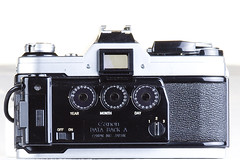Canon AE-1

|
| image by blind puppet (Image rights) |

|
| Canon AE-1 with FD 50mm f/1.8 lens. image by AWCam (Image rights) |
After its introduction in 1976, the Canon AE-1 quickly became a very popular camera worldwide, eventually selling millions of units. With a highly automated production process, a microprocessor to simplify the design, and a metalized-plastic top panel, Canon was able to keep costs low. The result was one of the first affordable TTL autoexposure SLR cameras to hit the market. (The majority of consumer-level cameras at that time had, at best, match-needle TTL exposure metering.)
The AE-1 offered a modest reduction in body size compared to earlier models like the FTb. The AE-1 has Canon's FD mount, and a typical kit includes the Canon FD 50mm f/1.8 lens. The lens in the top photo shown here has the original FD mount, with a chrome twist-ring to fasten the bayonet ("breech-lock" mount); later examples of the AE-1 have the new FD mount, in which the whole lens is twisted to fit it. With either version of the mount, the lens can be stopped down manually with the slider on the left of the mount, to check depth of field (or for stopped-down metering).
The focal-plane shutter travels horizontally, and has speeds 2 - 1/1000 seconds, and 'B', set with a dial around the hub of the film advance lever. All the fixed speeds are electronically timed. Flash synchronisation is at 1/60 sec with auto-switching, available through both PC connector and a hot shoe with a contact for dedicated flashguns. The self-timer is electronic with a delay of 10 seconds; it is selected by turning the lever at the left of the shutter release button to point forward (turning this lever backward, as in the lower picture here, locks the release button; the red lamp by the lever flashes as the self-timer counts down).
The exposure meter system is activated by pressing the shutter release half-way, or pressing the exposure meter button (the black button, to the left of the lens mount). It uses a silicon photo diode with a range of 1 to 18 EV (ISO 100). The finder has a matte screen with split image rangefinder surrounded by a microprism collar. The meter display is on the right in the viewfinder; it shows the aperture range (from f/1.2 to f/22); a needle drops down to indicate the meter reading. There are also LEDs to warn of low light (a red LED at the bottom of the scale if the light is too low to meter, or if the set shutter speed is too fast to allow a suitable aperture) and to show when the lens is set to manual aperture ('M' at the top of the scale). The camera also allows stopped-down metering; if the lens is stopped down, and either the shutter speed or the aperture is adjusted, the meter indicates correct exposure when the needle is at the marker half-way down the scale (next to f/5.6 on the scale). This allows metering with non-FD lenses mounted via an adapter. Holding the back light button (the small chrome button above the meter button, to the left of the lens mount) while exposing in AE increases the exposure by 1.5 stops.
The film is advanced with a single-stroke advance lever. The camera has contacts on the base to accept a power winder. Rewinding is by a folding crank on the left shoulder of the body; the button to release the film for rewind is in the base. The frame counter window is by the film advance lever; it counts upward, and resets automatically when the film chamber is opened. Rewinding the film also decreases the counter. The film speed is set in a window in the shutter speed dial (by lifting the knurled edge of the dial before turning it), between ISO 25 and 3200. The camera back has a film type memo holder (sized to hold the end of a film carton). An optional data back was also available.
The camera is powered by a 6V 4R44 battery with the battery compartment in the front of the camera. It can be opened easily with the hot shoe cover. The camera does not function at all without a battery. There is a battery check button on the top plate, to the left of the prism; the battery is adequate if the meter needle falls below the half-way marker when this is pressed.
With the success of the AE-1, Canon soon offered a lower-cost alternative (lacking autoexposure) in the form of the AT-1. Then in 1981 Canon released its followup model the AE-1 Program, which added a programmed autoexposure option.

|
| Data Back A image by zoomclic (Image rights) |
Links

|
| AE-1 black image by squirreltimes (Image rights) |
- Canon AE-1 at the Canon Camera Museum
- Modern Classics Review of the AE-1
- Manual Camera User's Opinion
- Repair notes for the "Canon Squeal" at Rick Oleson's website.
- AE-1 and the user's manual (in French) at Sylvain Halgand's Collection Appareils
- Canon AE-1 user's manual at Photo-Manuals.com
- The A Team an article about the SLR A models, AE-1, AT-1, A-1, AV-1 and AE-1 Program at Classic Cameras by RaúlM.
- Repair notes (in German) for "Canon Squeal"